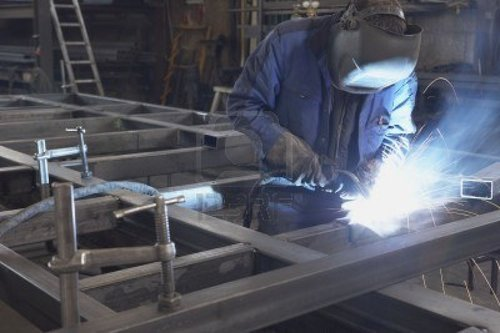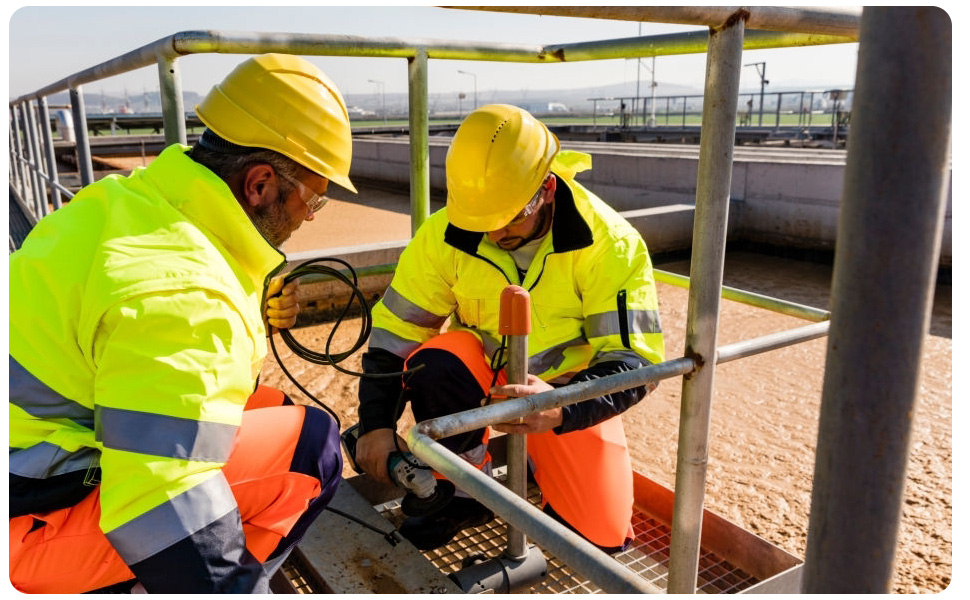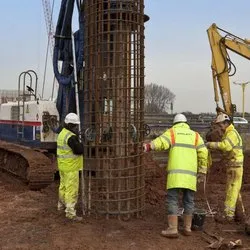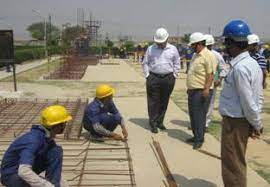Helper Fabrication (6 month course)
Helper Fabrication click here
Brief Job Description
Helper Fabrication workers are engaged in supporting works related to various process of fabrication like
cutting, welding, fitting, bolting and handling fabrication materials, tools and consumables under close
supervision of respective trade seniors.

Personal Attributes
The individual should be physically fit and mentally alert and safety conscious to be able to work across
various locations in extreme weather/site conditions. The person should preferably not suffer from any
respiratory disorder, vision defects and skin allergies due to exposure to light and heat and able to perform efficiently within a team, handle the various fabrication tools and materials
Identify, and handle materials, tools, tackles and
consumables used for fabrication of structural steel elements
Description
This unit describes the skills and knowledge required by workman to identify and handle materials, tools,
tackles and consumables used for fabrication of structural steel elements
Scope
The scope covers the following :
Identify and differentiate materials, tools and consumables used in the fabrication process
Handle tools, tackles, consumables and lightweight materials used in fabrication
Elements and Performance Criteria
Identify and differentiate materials, tools and consumables used in the fabrication process
To be competent, the user/individual on the job must be able to:
PC1. identify and differentiate between various types of Kits process of welding works
PC2. identify the various shielding gas cylinders
PC3. identify and differentiate between gases based on their uses and applications related to gas cutting works
PC4. identify and differentiate between different types of filler rods used in different welding processes
PC5. identify and differentiate types of grinding wheels
PC6. identify and differentiate between different types of grinders such as fixed grinding machine,
angle or portable grinders bend grinders etc.
PC7. identify and differentiate between various tools and tackles employed in fit up operations
Handle tools, tackles, consumables and lightweight materials used in fabrication
To be competent, the user/individual on the job must be able to:
PC8. handle and stack different tools that are required for welding operations
PC9. coil cables and pipes and shift them as per instructions
PC10. stack the wire/ cables as per manufactures guidelines as per standard safety norms and instruction
PC11. shift gas cylinders in upright position only, by employing trolleys or any other suitable
mechanical means
PC12. stack full and empty cylinders separately as per instructions or standard practice
PC13. shift lightweight materials as per instruction applying the ergonomics of material handling
PC14. stack the light weight material at proper location as per instruction
PC15. carry out basic upkeep of various hand tools and tackles
Knowledge and Understanding (KU)
The individual on the job needs to know and understand:
KU1. standard practices of fabrication works
KU2. safety rules and regulation for handling and storing required fabrication tools, equipment
and materials
KU3. personal protection including the use of related safety gears & equipment
KU4. procedure for issue of tools and materials
KU5. different types of welding processes
KU6. different kits, tools and tackles used in different welding processes
KU7. different types of consumables, their classification based upon size, material and application
in process
KU8. different types of gases used for fabrication activity and their distinguishing factors
KU9. importance of transporting gases in upright position
KU10. different types of grinding machines and their consumables
KU11. storage and stacking of different consumables used in different process of fabrication
KU12. various tools and tackles required in fabrication works
KU13. ergonomic principles to carry loads
Generic Skills (GS)
User/individual on the job needs to know how to:
GS1. write in one or more language, preferably in the local language of the site
GS2. read one or more language, preferably the local language of the site
GS3. read instructions, guidelines, sign boards, safety rules & safety tags
GS4. instruction related to exit routes during emergency at the workplace

GS5. speak in one or more language, preferably in one of the local language of thesite
GS6. listen and follow instructions / communication shared by superiors/ coworkers regarding team
requirements or interfaces during work processes
GS7. orally communicate with co-workers regarding support required to completethe respective
work
GS8. decide how to apply ergonomics principles while shifting and stacking light weight materials
GS9. identify location at which violation of any safety norms or protocols (with regards to stacking
of heavy objects, controlling position of suspended objects, etc.) may lead to accidents
Provide support and assistance to fabrication activities
Description
This unit describes the skills and knowledge required to have good working knowledge of fabrication to
enable the helper to provide assistance and support for fabrication activities
Scope
The scope covers the following :
Provide support in welding/ gas cutting/ grinding operations
Provide support in fitting operations
Carry out bolting connections under continuous instructions and close supervision for jigs and
fixtures
Elements and Performance Criteria
Provide support in welding/ gas cutting/ grinding operations
To be competent, the user/individual on the job must be able to:
PC1. carry welding tools equipment and consumables to instructed location
PC2. clean the base material to remove any dust, oil, rust, paint etc. from the surface as per
instructions
PC3. clean the base material to remove any dust. Oil, rust, paint, etc. from the surface as per
instructions
PC4. ensure that cables / gas pipes are not tangled
PC5. carry portable grinding machines and consumables to instructed locations
PC6. store and stack the consumables as per requirement/ instructions and guidelines
Provide support in fitting operations
To be competent, the user/individual on the job must be able to:
PC7. remove any scrap materials, dust etc. from the fabrication platform
PC8. place the clamps and arrestors in place as per instructions
PC9. store and stack required tools and tackles as per instructions
PC10. carry light weight material to proper position as per instruction
PC11. assist in measurement activity as per instructions
PC12. mark the measurements and alignment as per instructions
PC13. carry out cleaning of assemblies and components prior to erection of the same
Carry out bolting connections under continuous instructions and close supervision for jigs and fixtures
To be competent, the user/individual on the job must be able to:
PC14. identify the correct bolts for fixing as per instructions
PC15. identify the correct location of bolt/ group etc. as per instructions
PC16. identify and use washers and nuts as per instructions
PC17. tighten the bolts till desired torque is achieved as per instructions
PC18. fix the bolts in a sequential manner as per as instructions
PC19. ensure that no scratches are inflicted upon the surface during bolting operation
Knowledge and Understanding (KU)
The individual on the job needs to know and understand:
KU1. standard practices of fabrication works
KU2. safety rules and regulation for handling and storing required fabrication tools, equipment
and materials
KU3. personal protection including the use of related safety gears & equipment
KU4. how to request tools and materials as per set procedures
KU5. maintenance of tools and equipment
KU6. standard sizes of relevant fabrication tools
KU7. importance of clean joints in welding activity
KU8. process of removal of paint from base metal surface
KU9. process of removal of dust from base metal surface
KU10. importance of ventilation in welding
KU11. importance of proper illumination in welding
KU12. importance of proper fitting
KU13. process of preparing fabrication platform
KU14. importance of clamps and arrestors on fabrication platform
KU15. different tools and tackles required in fitting activity
KU16. importance of proper marking
KU17. procedure for marking on metal
KU18. different types of bolts
KU19. different methods of cleaning
KU20. components of a bolting assembly
KU21. common terminologies used in welding, gas cutting operations
KU22. common terminologies used in bolting and fitting operations
KU23. process of marking and measuring the dimensions of the assemblies
KU24. various tools and tackles used in joining assemblies through bolted connections
KU25. use and upkeep of different tools and tackles used
KU26. housekeeping, its importance and various practices involved

Generic Skills (GS)
User/individual on the job needs to know how to:
GS1. write in one or more language, preferably in the local language of the site
GS2. read in at least one language, preferably in the local language of the site
GS3. read instructions, guidelines, sign boards, safety rules and safety tags
GS4. instruction related to exit routes during emergency
GS5. SA5. speak in one or more languages, preferably in one of the local languages of the site
GS6. listen and follow instructions communicated by supervisors
GS7. communicate orally and efficiently with team member
GS8. ensure work is done within time and as per desired quality as per instructions provided by superiors
GS9. identify location at which violation of any safety norms may lead to accident
Work according to personal health, safety and environment protocol at construction site
Description
This NOS covers the skill and knowledge required for an individual to work according to personal health,
safety and environmental protocol at construction site
Scope
The scope covers the following :
Follow safety norms as defined by organization
Adopt healthy & safe work practices
Implement good housekeeping and environment protection process and activities
Elements and Performance Criteria
Follow safety norms as defined by organization
To be competent, the user/individual on the job must be able to:
PC1. identify and report any hazards, risks or breaches in site safety to the appropriate authority
PC2. follow emergency and evacuation procedures in case of accidents, fires, natural calamities
PC3. follow recommended safe practices in handling construction materials, including chemical
and hazardous material whenever applicable
PC4. participate in safety awareness programs like Tool Box Talks, safety demonstrations, mock
drills, conducted at site
PC5. select and operate different types of fire extinguishers corresponding to types of fires as per
EHS guideline
PC6. identify near miss , unsafe condition and unsafe act
Adopt healthy & safe work practices
To be competent, the user/individual on the job must be able to:
PC7. use appropriate Personal Protective Equipment (PPE) as per work requirements including:
Head Protection (Helmets), Ear protection, Fall Protection, Foot Protection, Face and Eye
Protection, Hand and Body Protection, Respiratory Protection (if required)
PC8. handle all required tools, tackles , materials & equipment safely

PC9. follow safe disposal of waste, harmful and hazardous materials as per EHS guidelines
PC10. install and apply properly all safety equipment as instructed
PC11. follow safety protocol and practices as laid down by site EHS department
PC12. undertake and pass height pass test as per EHS guideline
Implement good housekeeping and environment protection process and activities
To be competent, the user/individual on the job must be able to:
PC13. collect and deposit construction waste into identified containers before disposal, separate
containers that may be needed for disposal of toxic or hazardous wastes
PC14. apply ergonomic principles wherever required
Knowledge and Understanding (KU)
The individual on the job needs to know and understand:
KU1. reporting procedures in cases of breaches or hazards for site safety, accidents, and
emergency situations as per guidelines
KU2. types of safety hazards at construction sites
KU3. basic ergonomic principles as per applicability
KU4. the procedure for responding to accidents and other emergencies at site
KU5. use of appropriate personal protective equipment to be used based on various working conditions
KU6. importance of handling tools, equipment and materials as per applicable
KU7. health and environmental effect of construction materials as per applicability
KU8. various environmental protection methods as per applicability
KU9. storage of waste including the following at appropriate location: non-combustible scrap
material and debris, combustible scrap material and debris, general construction waste and
trash (non-toxic, non-hazardous), any other hazardous wastes, any other flammable wastes
KU10. how to use hazardous material, in a safe and appropriate manner as per applicability
KU11. types of fire

KU12. Procedure of operating different types of fire extinguishers
KU13. safety relevant to tools, tackles, & requirement as per applicability
KU14. housekeeping activities relevant to task
Generic Skills (GS)
User/individual on the job needs to know how to:
GS1. write in one or more languages, preferably in the local language of the site
GS2. fill safety formats for near miss, unsafe conditions and safety suggestions
GS3. read in one or more language, preferably in the local language of the site
GS4. read sign boards, notice boards relevant to safety
GS5. speak in one or more language, preferably in one of the local language of the site
GS6. listen instructions / communication shared by site EHS and superiors regarding site safety,
and conducting tool box talk
GS7. communicate reporting of site conditions, hazards, accidents, etc.
GS8. maintain safe conditions for others
GS9. keep the workplace clean and tidy
GS10. identify safety risks that affect the health, safety and environment for self and others
working in the vicinity, tackle it if within limit or report to appropriate authority
GS11. assess and analyze areas which may affect health, safety and environment protocol on the site
GS12. ensure personal safety behavior
GS13. respond to emergency







